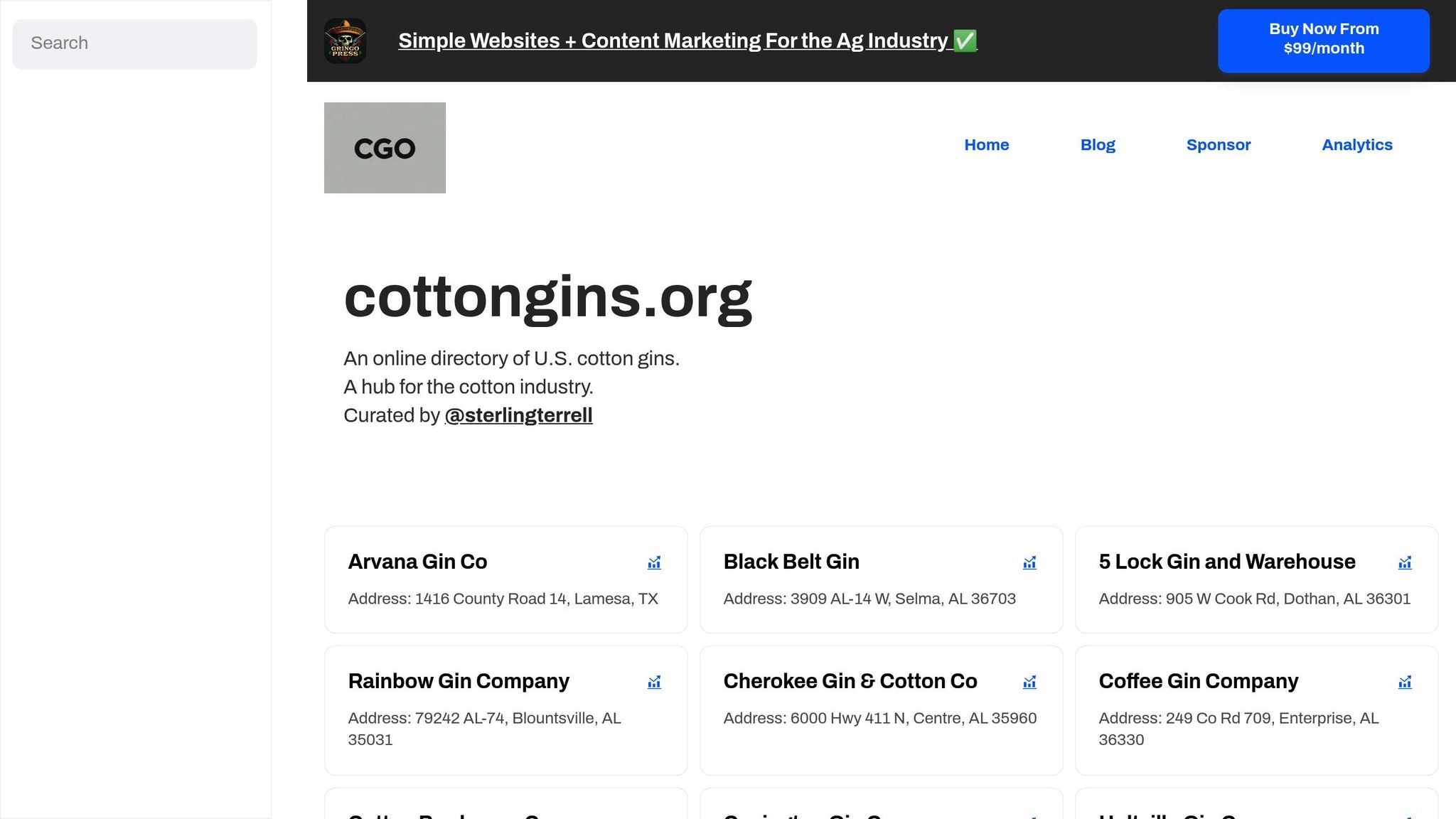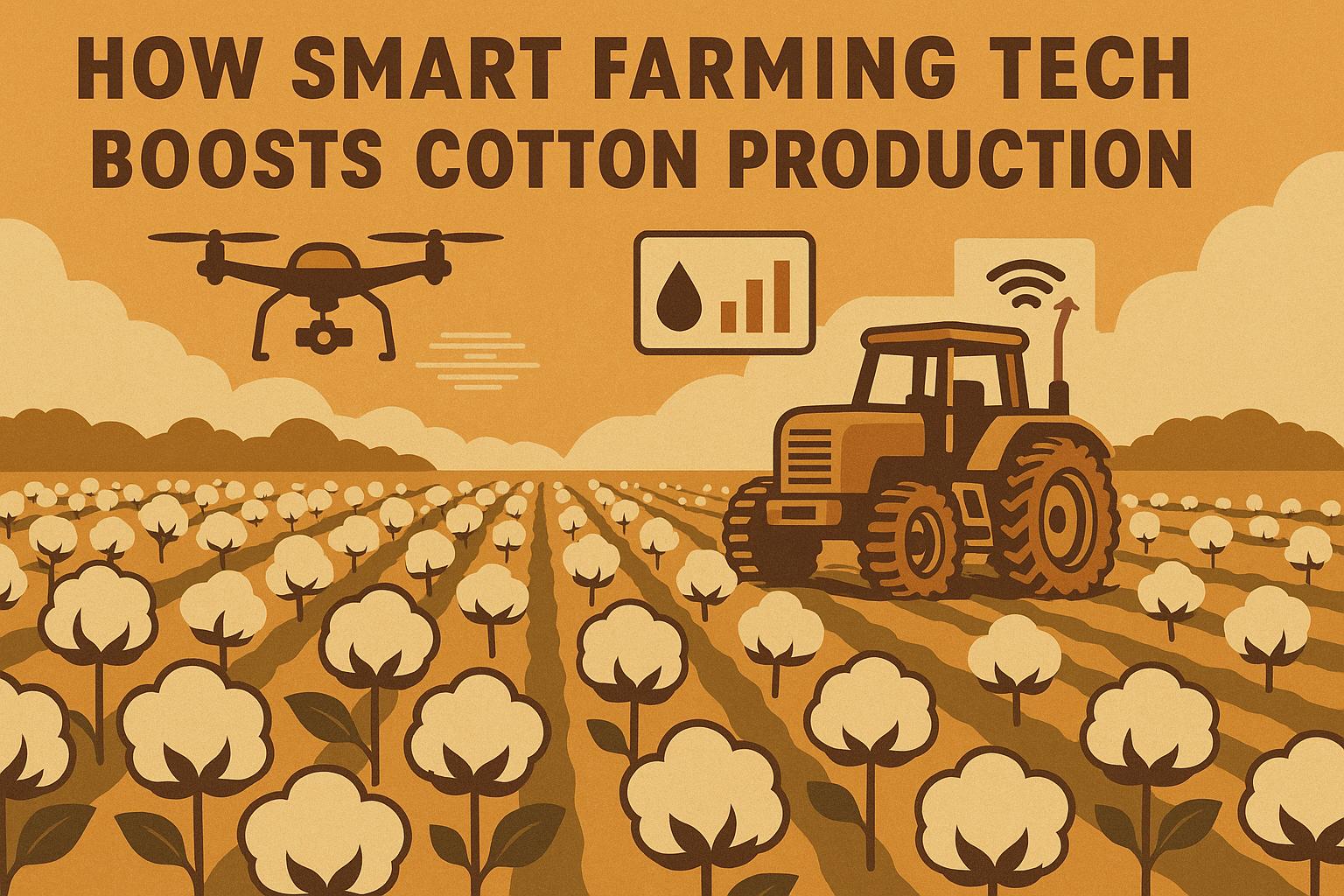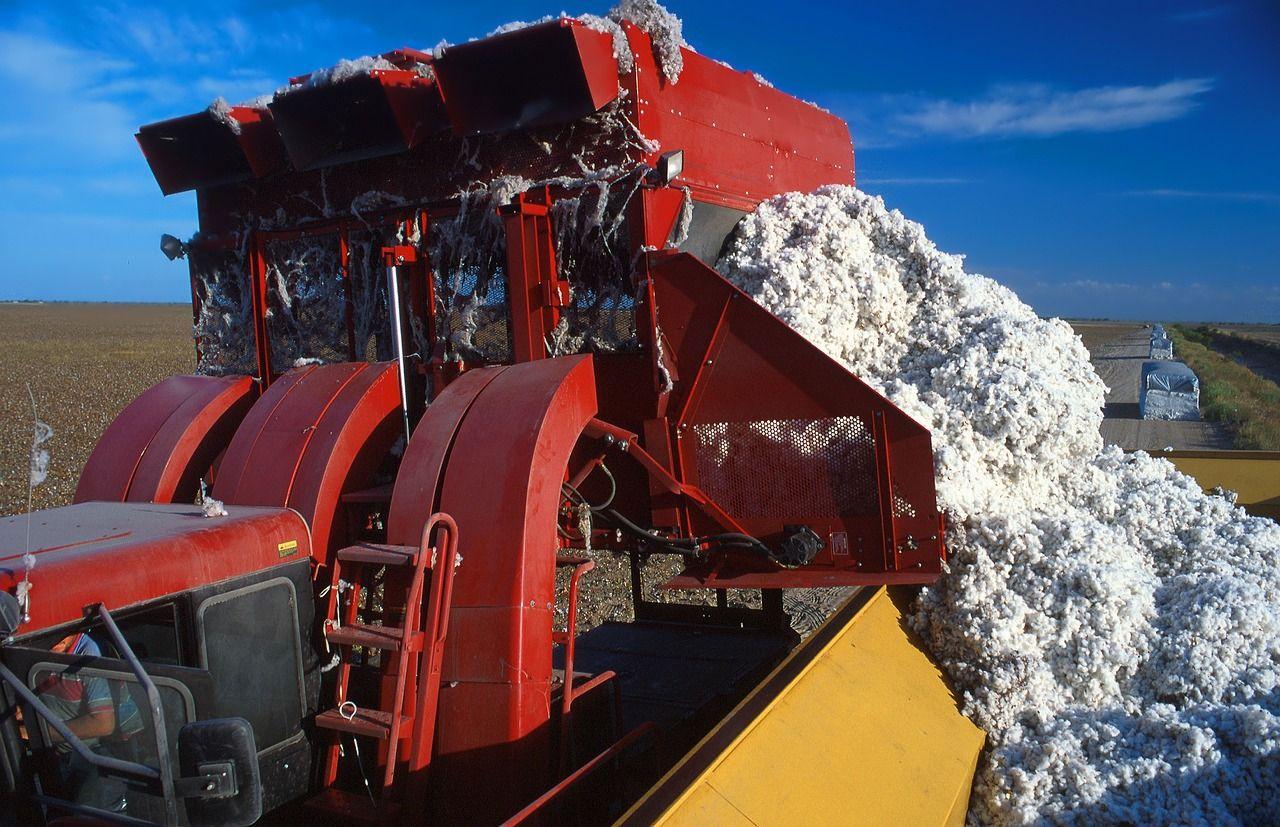Cotton gin waste (CGW) is the leftover material from separating cotton fibers from seeds. It’s often seen as a disposal problem, but it holds untapped potential in creating products like biodegradable plastics, agricultural amendments, and bioenergy. With the U.S. producing 6.2 billion pounds of CGW annually, reusing this byproduct could reduce waste, improve soil health, and cut emissions.
Key Takeaways:
- Bioplastics: CGW can replace petroleum-based plastics, offering better UV resistance and thermal stability.
- Agriculture: Biochar and compost from CGW improve soil quality, boosting crop yields by up to 315%.
- Bioenergy: CGW can generate renewable energy, reducing reliance on fossil fuels.
- Economic Benefits: Recycling CGW saves disposal costs and creates new revenue opportunities for cotton producers.
Challenges include high transportation costs, regulatory hurdles, and the need for better processing technology. Platforms like cottongins.org connect stakeholders to drive progress in reusing CGW effectively.
FREE COMPOST (HOW TO GET IT) Aged Cotton Gin Trash & Woods Rotary Tiller Demonstration / Review
Ways to Repurpose Cotton Gin Waste
Cotton gin waste (CGW) is finding new life in a variety of industries, turning what was once a disposal challenge into a resource with multiple uses. These innovative applications not only create new revenue opportunities but also address environmental issues. Here’s how CGW is being transformed into valuable products.
Biodegradable Plastics and Composite Materials
Cotton gin waste is proving to be a promising ingredient for producing biodegradable plastics, offering an alternative to traditional petroleum-based materials. Its lignocellulosic structure makes it ideal for composite materials, combining environmental benefits with enhanced material performance.
A 2021 study published in the Journal of Cleaner Production showcased a cost-efficient method of producing bioplastics using poly (vinyl alcohol) (PVA) and cotton gin trash. By incorporating urea as a plasticizer, the resulting material achieved a modulus of 257 MPa, surpassing the 213.5 MPa modulus of commercial low-density polyethylene (LDPE).
In April 2023, researchers from Deakin University and Cotton Incorporated developed biodegradable plastic films using CGT powder combined with polycaprolactone (PCL). This process involved a twin-screw extruder and polyethylene glycol (PEG) as a plasticizer. The resulting films exhibited better UV resistance, thermal stability, and Young's modulus compared to pure PCL.
"Overall, this study demonstrated a sustainable production method of CGT bio-plastic films using the whole CGT and without any waste residue produced, where the degradation of the produced composite films can be adjusted to minimize the environmental impact."
Additionally, in April 2024, the USDA Agricultural Research Service introduced a groundbreaking method to synthesize silver nanoparticles with antimicrobial properties from cotton gin waste. Research Engineer Sunghyun Nam highlighted the innovation:
"Our method not only lets cotton gin waste act as chemical agents for producing silver nanoparticles, which makes it cost-effective but also enables embedding the nanoparticles within the cotton gin waste matrix. By embedding them in the cotton gin waste, these materials acquire antimicrobial properties."
Given the global production of silver nanoparticles, estimated at 500 tons per year, this approach eliminates the need for expensive chemical agents, making it both practical and cost-efficient.
Agricultural Uses
Cotton gin waste is also being utilized in agriculture, particularly as a soil amendment to boost productivity. When processed into biochar or compost, CGW enhances the soil’s physical, chemical, and biological properties.
For instance, researchers in Brazos County, Texas, used cotton gin trash to create biochar, compost, and co-compost for soil applications. The results were striking: soil organic matter increased from 4.4% to 7.9%, and plant biomass improved by up to 31.5% compared to untreated plots.
When co-composted biochar was applied at a rate of 10 tons per hectare, radish plants experienced a 315% increase in biomass yield. Additionally, organic amendments enhanced leaf chlorophyll content by 20 to 30%, signaling healthier plant growth.
Greg Holt from the USDA-ARS Cotton Production and Processing Research Unit in Lubbock, Texas, sees even broader possibilities:
"It's a process of carbon capture that will be more valuable if carbon credits and funding become viable."
Cotton gins can process their waste into biochar through thermal chemical methods under oxygen-free conditions, providing growers with a soil amendment that improves moisture retention and overall soil health.
Bioenergy Production
Another promising avenue for cotton gin waste is its conversion into bioenergy, including biogas, biofuel, and other energy sources. This approach not only reduces dependency on fossil fuels but also offers a practical solution for managing the 2.5 million tons of biomass generated annually by cotton ginning.
Despite its potential, challenges remain, such as relatively low ethanol yields of 12–31% and heating values of 16.67 MJ/kg. Researchers are exploring improved processing techniques to overcome these limitations.
Gregory A. Holt from the USDA-ARS Cotton Production and Processing Research Unit emphasizes the economic benefits of this approach:
"We want to give ginners a way to sell their wastes for value-added applications."
Benefits for the Economy and Environment
Cotton gin waste (CGW) is being transformed from a disposal problem into a resource that reduces landfill use, cuts emissions, and decreases the demand for new cotton production.
Reducing Waste and Emissions
Repurposing CGW addresses major agricultural waste issues. In the U.S., nearly 11 million tons of textiles end up in landfills each year, contributing to methane emissions. By finding new uses for CGW, the need for resource-heavy cotton production is also reduced.
One promising option is bioenergy production. Research shows that burning cellulose biomass from discarded cotton textiles to generate electricity could save as much as 68 million tons of CO₂ equivalent annually. Programs like Blue Jeans Go Green™ showcase the potential impact. Since 2006, this initiative has recycled over 5.6 million pieces of denim, diverting more than 2,832 tons of textile waste from landfills. The recycled denim is turned into UltraTouch™ denim insulation by Bonded Logic, Inc..
These efforts not only cut emissions but also open doors to better soil management and financial opportunities.
Soil Health and Carbon Storage
Beyond reducing emissions, CGW can improve soil quality and help store carbon. With 50 million tons of CGW produced annually, this waste holds vast potential for boosting soil health. For example, in the Texas High Plains alone, cotton gin waste amounts to about 1–1.5 million metric tons each year. When converted into biochar, this waste becomes a long-term carbon storage solution. Raw cotton stalks, which contain about 46% carbon, see their carbon content rise to 83.2% after pyrolysis, offering a carbon sequestration rate of approximately 23.8%.
Field studies reveal that biochar not only enhances soil nitrogen levels but also increases cotton yields. Additionally, it has been shown to improve plant dry matter production and mitigate the harmful effects of PVC microplastics on soil enzymes and microbial life. Greg Holt from the USDA-ARS Cotton Production and Processing Research Unit highlights the potential for additional incentives:
"It's a process of carbon capture that will be more valuable if carbon credits and funding become viable."
Compost made with cotton-based biochar further supports soil reclamation and plant growth. Its high carbon content slows carbon mineralization, making it a valuable tool for sustainable agriculture.
New Revenue Opportunities for Cotton Producers
For cotton gin operators, CGW offers a chance to turn a financial burden into a profit. Traditional waste disposal is costly. For example, in Australia, managing and storing 100,000 tonnes of cotton gin trash can cost around $60,000 annually. Disposal costs for a single gin range between $110,000 and $130,770, while across 26 gins in New South Wales, the total annual expense reaches about $3.4 million.
By cutting these disposal costs, operators can instead profit by converting waste into marketable products. Options include biodegradable plastics, biochar for soil improvements, and biomass for energy production. For instance, producing biodegradable plastics from cotton gin trash has proven economically viable, with electricity and chemical costs per gram of film estimated at 0.02 and 0.18–0.19 AUD, respectively. Research Engineer Sunghyun Nam from ARS's Cotton Chemistry and Utilization Research Unit emphasizes the potential:
"Our research paves the way for new material applications of cotton gin waste that can protect against microbial contamination."
This shift - from a costly disposal problem to a revenue-generating opportunity - marks a major change in how the cotton industry views its byproducts, creating new business models that benefit both producers and the environment.
sbb-itb-0e617ca
Challenges in Scaling Up Circular Practices
While cotton gin waste (CGW) holds promise for both economic and environmental gains, scaling its use on a commercial level is no easy feat. The leap from small-scale projects to widespread adoption is hindered by a mix of logistical, regulatory, and technological challenges.
Supply Chain and Logistics Problems
Turning CGW into a viable resource comes with significant hurdles, especially when it comes to logistics. One of the main issues is the sheer difficulty of transporting large volumes of this low-density material. Unlike conventional commodities, CGW is bulky, lightweight, and scattered across thousands of locations nationwide. These factors drive up transportation costs, which can make or break the feasibility of repurposing efforts. Research shows that farmgate costs alone can account for up to 70% of the total delivered cost, with the remaining 30% covering expenses like loading, hauling, and receiving. Without efficient collection methods, costs at the factory gate can double compared to the farmgate price.
For instance, a 900 MW biomass power plant would require 4.3 million dry tons of fuel annually - equivalent to a 32-ton load arriving every four minutes. Kumar et al. highlighted the strain this would place on infrastructure:
"it is difficult to imagine a community or a local road system that could accept this traffic density".
Moisture content adds another layer of complexity, as transporting wet biomass means hauling significant amounts of water weight along with the material itself. Other logistical challenges include variations in texture, seasonal availability, low bulk density, and the wide geographic spread of the waste.
Regulatory Requirements
Navigating the regulatory landscape is another major obstacle in scaling up circular practices for CGW. Compliance requirements vary widely across states and applications, making it hard for companies to adopt standardized processes. Extended Producer Responsibility (EPR) policies, which aim to shift recycling costs from the public sector to the producers of goods, have shown potential but remain inconsistently applied. While the U.S. produces more plastic waste than any other country, only 8% of it gets recycled.
Some states have made strides in updating recycling standards. Vermont’s 2012 Universal Recycling Law, for example, set a timeline to ban recyclables, yard debris, and compostable food scraps from trash bins, yielding promising early results. Recycling expert David Hurd underscored the importance of addressing producer responsibility:
"The big elephant in the room is producer responsibility. We've got to shift the cost away from the public sector and put it back on the private sector – that creates the products to begin with".
These regulatory challenges highlight the pressing need for innovative research to drive progress.
Need for More Research and Development
Despite some early successes, technological gaps remain a significant barrier to scaling up CGW repurposing. The industry needs advancements in processing efficiency, cost reduction, and market adaptability to make commercial adoption feasible.
One potential solution could be mobile machinery capable of converting CGW into biochar, offering a cost-effective option for gin owners who can’t justify investing in permanent pyrolysis units. Greg Holt from the USDA-ARS Cotton Production and Processing Research Unit acknowledged the difficulty of this task:
"Someone smarter than I am will figure this out. It could be soon, the market and the technology coming together at the right time".
Holt also pointed out a critical issue:
"sometimes, energy costs outweigh product benefits".
Encouragingly, advancements in cotton gin technology are paving the way for progress. These include increased automation, the use of data analytics for real-time monitoring, and a growing emphasis on sustainable practices. The integration of smart systems and IoT technologies could also transform how CGW is processed and tracked.
Holt remains optimistic about the future:
"It's an organic material that offers a lot of sustainable opportunities. We just need to find a universal home for it rather than a niche market".
Ongoing research and the ability to adapt to changing technologies and market demands will be critical in finding scalable solutions for repurposing CGW.
How cottongins.org Supports Circular Economy Efforts

The cotton industry faces the challenge of scaling up sustainable practices for handling cotton gin waste. This is where cottongins.org steps in, providing essential connections and resources to support these efforts and foster collaboration among stakeholders.
Connecting Industry Players Through cottongins.org
At its core, cottongins.org functions as a comprehensive U.S. cotton gin directory, covering facilities in major cotton-producing states across the country. For businesses seeking cotton gin waste for their operations or researchers working on innovative reuse technologies, the directory simplifies the process. By identifying gins in specific regions, it enables direct communication and collaboration. Cotton gin operators can also keep the directory current using a submission form, ensuring the information stays relevant and up-to-date.
Beyond being a connection hub, the platform also plays a key role in expanding industry knowledge.
Promoting Better Practices
cottongins.org doesn’t stop at providing a directory - it also promotes sustainable practices through knowledge sharing. The platform offers a blog subscription, keeping users informed about industry trends and updates, including progress in circular economy practices.
Moreover, sponsorship opportunities on the platform allow companies to showcase their innovations. Through sponsored posts, businesses can share their technologies and success stories related to cotton gin waste management. These posts remain accessible in the archives, building a growing repository of industry insights and practical solutions.
Conclusion
The United States generates an immense 6.2 billion pounds of cotton gin waste annually, stemming from 21.1 million bales of cotton processed in 2019. Finding ways to repurpose this waste offers a meaningful opportunity for economic growth and environmental progress.
Key Points
Turning cotton gin waste into useful products has proven to deliver both financial and ecological benefits. For instance, FGH International Agribusiness Consulting launched the "From Trash to Treasure" project in Chihuahua, Mexico. Over the last two years, this initiative has repurposed more than 2 million pounds of gin trash each year, reducing cattle feed costs by over 25% while eliminating harmful emissions from burning waste.
The push toward cotton recycling is also creating jobs in the recycling industry, aligning with the growing demand for sustainable products. This shift not only benefits the environment but also strengthens the economy by opening new avenues for employment and innovation.
However, scaling these efforts remains a challenge. Overcoming supply chain inefficiencies, navigating regulatory barriers, and advancing research and development will require collaboration across the industry. Platforms like cottongins.org are stepping in to connect stakeholders and drive progress.
Repurposing cotton gin waste into products like biodegradable plastics, agricultural inputs, and bioenergy represents a smart step toward a circular economy. By transforming waste into resources, businesses can unlock new revenue streams while contributing to a healthier planet for future generations. This approach is more than just environmentally responsible - it’s a forward-thinking business strategy.
FAQs
What challenges arise when repurposing cotton gin waste for a circular economy?
Repurposing cotton gin waste to support circular economy efforts isn't without its hurdles. One major challenge is sorting and handling materials, especially when dealing with blends or contaminants that complicate the process. On top of that, the fiber quality often deteriorates during processing, which can limit how effectively the material can be reused.
There are also issues tied to recycling infrastructure - or the lack of it - which can make efficient waste management difficult. Add to that the economic challenges, where the costs of repurposing might sometimes exceed the potential benefits. Lastly, cotton dust emissions pose an environmental concern that requires careful management to mitigate any harmful effects.
How does recycling cotton gin byproducts as soil amendments benefit farming?
Recycling cotton gin byproducts as soil amendments offers a practical way to enhance farming efficiency. These byproducts add organic matter to the soil, which improves its structure and boosts fertility. They also help the soil retain more water, giving crops better access to moisture during dry spells. On top of that, the nutrients in cotton gin waste promote healthier plant growth, which can lead to higher crop yields.
This approach doesn’t just benefit agriculture - it’s a smart way to repurpose waste. By reusing these materials, farmers can reduce environmental impact and make better use of available resources, supporting a circular economy in the process.
How does cottongins.org help promote the reuse of cotton gin byproducts in the industry?
Cottongins.org serves as a hub for advancing the reuse of cotton gin byproducts, encouraging collaboration and the exchange of ideas within the industry. The platform emphasizes creative methods to repurpose byproducts, such as turning cotton gin waste into resources like compost, fertilizer, and biofuel.
Through connecting industry experts and sharing success stories, Cottongins.org inspires practices that promote a more efficient and sustainable approach. This reduces waste, optimizes resource use, and strengthens efforts toward environmental responsibility within the cotton industry.


